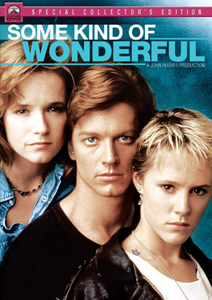“Some Kind of Wonderful” (1987) offers little we haven’t seen in other movies, but it has such heart and such an easygoing, naturalistic charm that it’s, well, some kind of wonderful little gem. Writer John Hughes and director Howard Deutch – in the second of their three collaborations – treat a teen love triangle and associated issues with the maturity and respectability of an adult romance film, eschewing big laughs.
This is one of those “romantic comedies” that is much more of the former than the latter.
Mature cast
The actors also look mature, as this is yet another teen movie starring 20-somethings, but that fits with the aesthetic. Indeed, part of the journey of Eric Stoltz’s Keith Nelson – hounded by his dad (John Aston as Cliff) to pick a college — is to become his own man.
Unusual for an 18-year-old, Keith knows what he wants: to be an artist and to date Amanda Jones (“Back to the Future’s” Lea Thompson).
Stoltz, with his hair making him a dead ringer for Mark Hamill from a decade earlier, has a soft voice that paints him close enough to being an innocent teen.
And as focused as Keith is on what he wants, he is oblivious to at least one thing: the love of his tomboy best friend, Watts (Mary Stuart Masterson) – even though Watts confesses her love to him long before it clicks in his head.
“The only things I care about in this goddamn life are me and my drums and you,” Watts says in one of several scenes where Masterson does such good acting with her sad eyes and slight scowl.
Refusal to recognize
Rather than a plot hole, Keith’s failure to recognize what Watts is saying is actually a temporary refusal to recognize it. The whole of “Some Kind of Wonderful” is a portrayal of how little things to an outside observer are the biggest things in the world to a teen, and when you’re laser-focused on one thing (as Keith is on Amanda), you can miss out other obvious (in retrospect) things.
For all its clichés — including the rich jerk, Craig Sheffer’s Hardy Jenns, who views Amanda as his “property” – “SKOW” isn’t exactly a rote exercise in letting the expected beats play out. For one thing, it’s unclear how much Amanda knows about Hardy’s plan to lure Keith to his house party for the sake of beating him up.
To cite another example, when Watts eyes Amanda in the locker room, the scene could be read as 1, she’s attracted to Amanda, or 2, she’s studying Amanda’s feminine qualities and wondering if she can duplicate them so Keith notices her.
It’s 1987, so lesbians are a known quantity, but only enough so a main character can be insulted with the accusation of being one, not so they actually would be one.
That’s not necessarily a criticism; if this story was remade today, Watts would definitely be into Amanda — everything is a product of its time, and carries some predictability because of that.

Another influence on ‘Creek’
Another riff on this type of love triangle is Season 1 of “Dawson’s Creek” – with Dawson being obsessed with Jen while taking the pining Joey for granted – but by 1998 TV teens were aware that they were playing out storylines from Hughes movies.
(Also in 1998, “Can’t Hardly Wait” does a comedic riff on “SKOW’s” party showdown scene. Probably not coincidentally, both dream girls are named Amanda.)
In “SKOW,” the teens are not armed with much foreknowledge, so I fear for Keith, Watts and Amanda getting their hearts broken.
Interestingly, Hughes does try the trick of having a kid speak with knowledge beyond her years, but he does it via Keith’s youngest sister, Cindy (Candace Cameron). It’s the film’s only attempt at absurdist humor, and it doesn’t fit with the subtlety elsewhere.
Truths from a skewed angle
It’s the truths that make “SKOW” shine, even when those truths come from a skewed angle. Keith’s other sister, Laura (Maddie Corman), claims to find her brother uncool but secretly hopes he’s her ticket into the cool club.
And the school tough known as Skinhead (Elias Koteas, in the role that might’ve landed him the Casey Jones gig in “Teenage Mutant Ninja Turtles”) turns out to be a solid dude who bonds with Keith over art in detention.
Featuring a delicate score by Stephen Hague and John Musser, choice soundtrack cuts like a Celtic cover of “I Can’t Help Falling in Love,” and the promise and beauty of 1987 Los Angeles through Jan Kiesser’s lens, “SKOW” is, broadly speaking, a crowd-pleaser.
The fact that Amanda is genuinely fine with Keith choosing Watts – she even encourages him to do so – clinches that status.
In a vacuum, “Some Kind of Wonderful” is arguably a lazy, convenient piece of writing. But Hughes doesn’t always write to surprise people; sometimes he writes to let well-cast actors play out beats from the heart.


